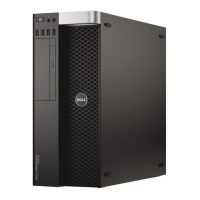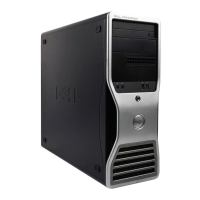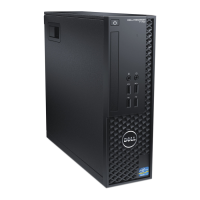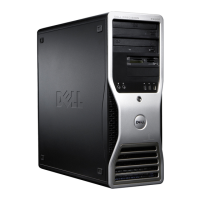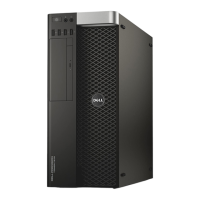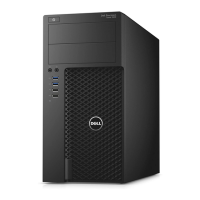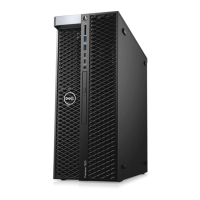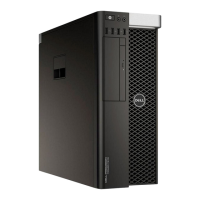Do you have a question about the Dell Precision T5600 and is the answer not in the manual?
Safety and preparation steps before accessing internal components.
Procedures to safely shut down the computer before maintenance.
Steps to reconnect devices and power on after internal work is complete.
Lists tools required for component removal and installation procedures.
Steps to remove and install the computer's power supply unit.
Steps to remove and install the main chassis cover.
Procedures for removing and installing the optical drive.
Steps to remove and install the thermal sensor.
Steps to remove and install the computer's hard drive.
Steps to remove and install the air tunnel component.
Steps to remove and install memory modules.
Steps to remove and install the coin-cell battery.
Steps to remove and install the heat sink assembly.
Steps to remove and install the heat sink fan.
Steps to remove and install the processor.
Steps to remove and install the system fan assembly.
Steps to remove and install the PSU card.
Steps to remove and install the front bezel.
Steps to remove and install the front I/O panel.
Steps to remove and install the internal speaker.
Steps to remove and install the system board.
Steps to install components onto the system board.
Identifies and describes components on the system board.
Guidelines for installing memory modules for optimal performance.
Explanation of the PSU lock feature and its operation.
How to boot directly to a device and navigate setup menus.
Options for System Board, Date/Time, Boot Sequence, and Boot List.
Settings for Integrated NIC, USB, Serial Port, SATA, and SMART.
Options related to Multi-Core, SpeedStep, TurboBoost, and memory access.
Options for virtualization, TPM, and password configurations.
Settings for AC recovery, auto-on, deep sleep, fan control, and Computrace.
Procedure for updating the system BIOS.
Step-by-step guide to assign system and setup passwords.
How to change, delete, or disable system passwords.
Overview of the ePSA diagnostic tool for comprehensive hardware checks.
Explains the POST diagnostic LEDs and their patterns for troubleshooting.
Categorizes and lists BIOS error messages based on severity.
Lists errors that stop computer operation and require power cycle.
Lists errors requiring user interaction to continue or enter setup.
Details processor types, cache, and core counts.
Chipset and BIOS chip specifications.
Specifications for memory connectors, capacity, and types.
Details video output connectors and integrated audio codec.
Network controller specs and expansion bus types/speeds.
Specifications for drive bays and accessibility.
Lists external audio, network, serial, and USB connectors.
Details internal connectors for power, fans, memory, processor, and buses.
Explains power button, drive activity, network, and diagnostic lights.
Specifications for coin-cell battery, voltage, and wattage.
Dimensions and weight specifications for different models.
Operating and storage temperature, humidity, vibration, and shock details.
Safety and preparation steps before accessing internal components.
Procedures to safely shut down the computer before maintenance.
Steps to reconnect devices and power on after internal work is complete.
Lists tools required for component removal and installation procedures.
Steps to remove and install the computer's power supply unit.
Steps to remove and install the main chassis cover.
Procedures for removing and installing the optical drive.
Steps to remove and install the thermal sensor.
Steps to remove and install the computer's hard drive.
Steps to remove and install the air tunnel component.
Steps to remove and install memory modules.
Steps to remove and install the coin-cell battery.
Steps to remove and install the heat sink assembly.
Steps to remove and install the heat sink fan.
Steps to remove and install the processor.
Steps to remove and install the system fan assembly.
Steps to remove and install the PSU card.
Steps to remove and install the front bezel.
Steps to remove and install the front I/O panel.
Steps to remove and install the internal speaker.
Steps to remove and install the system board.
Steps to install components onto the system board.
Identifies and describes components on the system board.
Guidelines for installing memory modules for optimal performance.
Explanation of the PSU lock feature and its operation.
How to boot directly to a device and navigate setup menus.
Options for System Board, Date/Time, Boot Sequence, and Boot List.
Settings for Integrated NIC, USB, Serial Port, SATA, and SMART.
Options related to Multi-Core, SpeedStep, TurboBoost, and memory access.
Options for virtualization, TPM, and password configurations.
Settings for AC recovery, auto-on, deep sleep, fan control, and Computrace.
Procedure for updating the system BIOS.
Step-by-step guide to assign system and setup passwords.
How to change, delete, or disable system passwords.
Overview of the ePSA diagnostic tool for comprehensive hardware checks.
Explains the POST diagnostic LEDs and their patterns for troubleshooting.
Categorizes and lists BIOS error messages based on severity.
Lists errors that stop computer operation and require power cycle.
Lists errors requiring user interaction to continue or enter setup.
Details processor types, cache, and core counts.
Chipset and BIOS chip specifications.
Specifications for memory connectors, capacity, and types.
Details video output connectors and integrated audio codec.
Network controller specs and expansion bus types/speeds.
Specifications for drive bays and accessibility.
Lists external audio, network, serial, and USB connectors.
Details internal connectors for power, fans, memory, processor, and buses.
Explains power button, drive activity, network, and diagnostic lights.
Specifications for coin-cell battery, voltage, and wattage.
Dimensions and weight specifications for different models.
Operating and storage temperature, humidity, vibration, and shock details.
| Tcase | 77.4 °C |
|---|---|
| Bus type | QPI |
| Stepping | C2 |
| FSB Parity | No |
| Processor cache | 15 MB |
| Processor cores | 6 |
| Processor model | E5-2620 |
| System bus rate | 7.2 GT/s |
| Processor series | Intel Xeon E5-2600 |
| Processor socket | LGA 2011 (Socket R) |
| Processor threads | 12 |
| Processor codename | Sandy Bridge EP |
| Number of QPI links | 2 |
| Processor frequency | 2 GHz |
| Processor cache type | Smart Cache |
| Processor lithography | 32 nm |
| Processor manufacturer | Intel |
| Processor front side bus | - MHz |
| PCI Express slots version | 3.0 |
| Processor boost frequency | 2.5 GHz |
| Processor operating modes | 64-bit |
| ECC supported by processor | Yes |
| PCI Express configurations | x4, x8, x16 |
| Thermal Design Power (TDP) | 95 W |
| Number of processors installed | 1 |
| CPU multiplier (bus/core ratio) | 25 |
| Maximum number of PCI Express lanes | 40 |
| Memory types supported by processor | DDR3-SDRAM |
| Memory clock speeds supported by processor | 800, 1066, 1333 MHz |
| Memory bandwidth supported by processor (max) | 42.6 GB/s |
| Maximum internal memory supported by processor | 750 GB |
| Internal memory | 16 GB |
| Memory channels | Quad-channel |
| Memory clock speed | 1600 MHz |
| Maximum internal memory | - GB |
| Memory layout (slots x size) | 4 x 4 GB |
| HDD speed | 7200 RPM |
| RAID levels | 0, 1, 5, 10 |
| HDD interface | SATA |
| Storage media | HDD |
| Optical drive type | DVD±RW |
| Card reader integrated | - |
| Total storage capacity | 1000 GB |
| Cooling type | Active |
| Discrete graphics card model | AMD FirePro W5000 |
| Discrete graphics card memory | 2048 GB |
| Operating system installed | Windows 7 Professional |
| Cabling technology | 10/100/1000Base-T(X) |
| Ethernet LAN data rates | 10, 100, 1000 Mbit/s |
| USB 2.0 ports quantity | 8 |
| VGA (D-Sub) ports quantity | 0 |
| PCI Express x16 slots | 4 |
| Chassis type | Midi Tower |
| Product color | Black |
| Product type | Workstation |
| Scalability | 2S |
| Processor ARK ID | 64594 |
| Processor package size | 52.5 x 45.0 mm |
| Supported instruction sets | AVX |
| Intel® Turbo Boost Technology | 1.0 |
| Physical Address Extension (PAE) | 46 bit |
| Intel Secure Key Technology version | 1.00 |
| Intel Identity Protection Technology version | 0.00 |
| Power supply | 635 W |
| Sustainability certificates | ENERGY STAR |
| Depth | 471 mm |
|---|---|
| Width | 172.6 mm |
| Height | 414 mm |
| Weight | - g |
